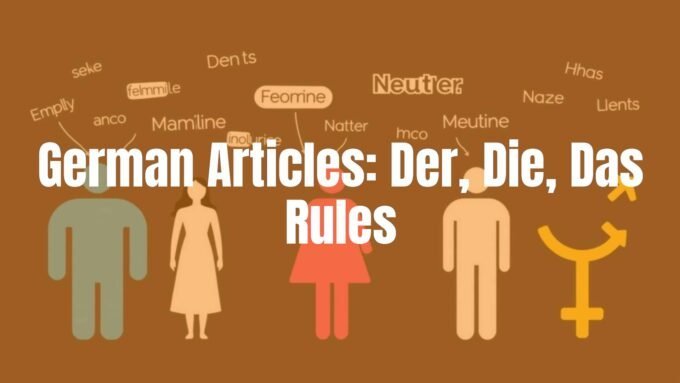German separable verbs, or “trennbare Verben,” are a common and sometimes tricky part of German. The short answer: they are compound verbs that split into two parts in certain sentence types. Think of them as verbs with a prefix that can move. Each verb has a base and a prefix, and the prefix often adds a new or more exact meaning. Learning these verbs well is very important for clear, natural German, because they appear all the time in everyday speech and writing.
This feature adds some difficulty but also gives you more ways to say things. Like English phrasal verbs (for example, “check out” vs. “check”), the prefix can change the base verb’s meaning a lot. “Gehen” means “to go,” but “ausgehen” means “to go out” (socially). Building words by adding prefixes to verbs, adjectives, or even nouns is a common feature of German, which makes it both hard and rewarding to learn.
How do separable verbs differ from inseparable verbs?
The main difference shows up in sentences. Separable verbs have a prefix that detaches and goes to the end of the clause in some cases. You need to learn this rule by heart. For example, with “anrufen” (to call), you say “Ich rufe Vera an” in the present tense, with “an” at the end.
Inseparable verbs keep their prefix attached at all times, no matter the tense or sentence type. The prefix and verb stay as one word. For example, “bezahlen” (to pay): “Ich bezahle die Rechnung” (I pay the bill). The prefix does not move. Stress can help you guess: inseparable prefixes are often unstressed, while separable prefixes carry the stress in the infinitive. This difference is a basic part of how German sentences work.

Why are separable verbs important in German?
Separable verbs are a very important part of German. They help grow your vocabulary and let you say things more exactly. Their value comes from several points. First, they are everywhere; you will meet them all the time in speaking and reading. Without them, understanding German gets hard fast. Next, prefixes add clear directional or idea-based meanings that change the base verb, so a small set of roots can cover many ideas. Learning these verbs helps you understand others and also say what you mean with more accuracy.
Also, getting good at separable verbs gives you a better feel for German logic and sentence order. It helps you move past word-for-word translation and start to think in German, which you need for real fluency. Placing the prefix correctly shows good control of German word order and makes your speech and writing flow better. These verbs also open the door to longer sentences and more exact meanings.
Common prefixes for German separable verbs
German separable verbs are largely shaped by their prefixes. These short parts can change a base verb’s meaning in a big way, making actions more specific, directional, or figurative. Learning common prefixes is like getting a key to a large set of verbs. While the number of verbs may feel hard at first, seeing patterns in prefixes can make learning much easier. Many prefixes are also prepositions, which gives you a hint about their meaning when attached to a verb.
Grouping verbs by prefix is a very effective way to learn. It builds links in your memory and helps you guess the meaning of new verbs. You are not just memorizing single verbs, but learning the pieces that build them. Once you know the usual meaning a prefix adds, you can use that idea with many verbs and grow your active vocabulary a lot.
What are the most frequent separable prefixes?
Some prefixes appear very often, so learn them early. They often show space or movement ideas, which then expand to other meanings with different verbs. Common ones include:
- an-: often means “to begin,” “to start,” or “on/at.”
- auf-: usually “up,” “upward,” or “open.”
- aus-: usually “out” or “outside.”
- ein-: “in,” “into,” or “inward.”
- ab-: “off,” “down,” or “away from.”
- mit-: “with” or “along.”
- nach-: “after” or “behind.”
- vor-: “before,” “forward,” or “in front of.”
- zu-: “closed,” “down,” or “toward.”
- zurück-: “back” or “return.”
- fern-: “far” or “distant.”
- weiter-: “further” or “to continue.”
These prefixes are among the most used. If you learn their basic ideas, you gain a strong tool for using and understanding many verbs. The fine meaning depends on the base verb, but these summaries are a good start.
Prefixes that can be separable or inseparable
Some prefixes can be either separable or inseparable. Their behavior and meaning change based on whether they split. This usually depends on stress: if the prefix is stressed, it is usually separable; if the stem is stressed, it is inseparable. This sound clue helps a lot, but it takes practice.
Common examples are durch-, um-, über-, unter-, and wieder-. For example, “umfahren” can mean “to drive around” (separable: “umfahren”) or “to run over” (inseparable: “umfahren“). The meaning changes a lot, so stress matters. Another case: “wiederkommen” (to return) is separable, while “wiederholen” (to repeat) is inseparable. You often have to learn these verb by verb, because general rules do not always fit neatly here.
Prefixes that look similar but do not separate
Some prefixes look like separable ones but are always inseparable. They stay attached in all forms. Here, you must memorize them, since looks alone do not give you a rule. These prefixes are usually unstressed.
The main inseparable prefixes are: be-, emp-, ent-, er-, ge-, miss-, ver-, and zer-. For example, “bekommen” (to get/receive) is always inseparable, and so is “verstehen” (to understand). You would not say “Ich stehe sehr gut Deutsch ver.” These prefixes often come from older roots and feel more built into the verb, not like separate particles. Knowing this group is important to avoid common mistakes and to make your German sound natural.
How do separable verbs work in German sentences?
The special behavior of separable verbs shows up in sentence order. Unlike many English phrasal verbs, German separable verbs send the prefix to the end of the clause. This is a key rule in German word order, and learning when and where the split happens is very important. You need to know not just that they split, but also when they do.
How a separable verb behaves depends on the type of clause and other verbs in the sentence. The same verb can look different based on context. This can be hard at first, but it gives German sentences a clear and flexible structure.
When do separable verbs split?
They usually split when they are the main verb in a main clause, in the present, simple past (Präteritum), and future. The base verb is conjugated and goes in second position, and the prefix moves to the end of the clause. This is the most common pattern and often the one that confuses learners at the start.
For example, “I get up at 7 o’clock”: “aufstehen” splits. “Stehe” is in second position, and “auf” goes to the end: “Ich stehe um 7 Uhr auf.” This split is a clear feature of separable verbs and helps you tell them apart from inseparable ones. Once you get this rule, it opens up a big part of German sentence building.

Where is the prefix placed after separation?
After a split, the prefix moves to the very end of the clause. This final spot is fixed and works in different sentence types. In statements, questions, or commands, the prefix will be the last piece. This steady placement makes it easier to find the prefix once you notice a separable verb.
Examples: “Morgen fange ich meinen neuen Job an” (Tomorrow I will start my new job), where “an” is at the end. In a question, “Siehst du oft fern?” (Do you watch television often?), “fern” is still last. In a command, “Ruf Vera an!” (Call Vera!), “an” comes last. This predictable final position is a useful anchor for correct sentences with separable verbs.
How do separable verbs behave with modal verbs and participles?
Things change with modal verbs or participles. With a modal verb (like können, müssen, wollen), the separable verb does not split. It stays together in the infinitive and goes to the very end, after the modal. For example, “Ich muss morgens normalerweise um 7 Uhr aufstehen” (I normally need to get up at 7 am). Here, “aufstehen” stays together at the end. This comes up a lot, since German often uses modals for possibility, need, or desire.
With participles, especially in the perfect tenses (Perfekt, Plusquamperfekt) or as adjectives, the “ge-” goes between the separable prefix and the stem. “Abgeben” (to hand in) becomes “abgegeben” as a participle. For example, “Wir haben das Paket abgegeben” (We delivered the package). This “ge-” inside the verb is a clear sign of a separable verb in a past form or as an adjective. In “um… zu” infinitive clauses, “zu” also goes between the prefix and the stem, as in “um uns einen besseren Plan auszudenken” (in order to come up with a better plan).
When are separable verbs not split?
Besides with modals and participles, there are cases where separable verbs stay together. In a subordinate clause, they do not split. The whole verb goes to the end of the subordinate clause. This is an important rule, since subordinate clauses are very common. For example, “Da ich morgens normalerweise um 7 Uhr aufstehe, versuche ich vor Mitternacht ins Bett zu gehen” (Since I normally get up at 7 am, I try to go to bed before midnight) shows “aufstehe” as one word.
In general, the split happens in main clauses where the separable verb is the only conjugated verb. In other cases-like with auxiliary verbs (haben, sein) in the perfect tenses, with modal verbs, or in subordinate clauses-the verb stays in one piece. Knowing these “no-split” cases matters as much as knowing when to split, because it prevents common errors and helps you build correct sentences.
German separable verbs list by prefix
A clear plan helps a lot with separable verbs. Grouping them by prefix is one of the best ways to learn and remember them. Each prefix adds a steady core idea to the base verb, so it works like a memory aid. When you know what a prefix usually adds, you can often guess the meaning of new verbs. Below is a selected list of common separable verbs by prefix to help you grow your vocabulary.
This is not a full list, since German makes many compound words. Still, focusing on these frequent prefixes and their verbs gives you enough to handle most daily talk and reading. Try to learn the idea the prefix adds, not just the translation.
Separable verbs with an-
The prefix an- is very common and flexible. It often means “to begin,” “to start,” “on,” or “at.” It can suggest an action aimed toward something or the start of an activity. Common verbs with an- include:
- anfangen (to begin, to start) – Wir fangen den Kurs nächste Woche an. (We start the course next week.)
- ankommen (to arrive) – Der Zug kommt jetzt an. (The train is arriving now.)
- anhaben (to wear, to have on) – Was hast du heute an? (What are you wearing today?)
- anmachen (to turn on, to light) – Kannst du bitte das Licht anmachen? (Can you please turn on the light?)
- ansehen (to look at, to view) – Ich sehe mir den Film an. (I’m watching the film.)
- anrufen (to call on the phone) – Ich rufe meine Freundin an. (I call my friend.)
- anpassen (to adapt, to adjust) – Er passt sich schnell an die neue Umgebung an. (He adapts quickly to the new environment.)
- anbieten (to offer) – Sie bietet mir einen Kaffee an. (She offers me a coffee.)
- anmelden (to register) – Ich muss mich für den Kurs anmelden. (I have to register for the course.)
- anziehen (sich) (to get dressed) – Zieh dich schnell an! (Get dressed quickly!)
Notice how “an-” often adds a sense of starting, attaching, or aiming at something.
Separable verbs with auf-
The prefix auf- often shows “up,” “upward,” or “open.” It can mean rising, starting an action that goes upward, or opening something. This prefix is very common in daily life.
- aufstehen (to get up, to rise) – Ich stehe um sieben Uhr auf. (I get up at seven o’clock.)
- aufhören (to stop, to finish) – Hör bitte auf zu reden! (Please stop talking!)
- aufmachen (to open) – Die Geschäfte machen am Sonntag auf. (The shops open on Sunday.)
- aufnehmen (to accept, to record) – Sie nehmen neue Studenten auf. (They accept new students.)
- aufpassen (to pay attention, to look after) – Pass gut auf deine Sachen auf! (Look after your things carefully!)
- aufräumen (to tidy up, to clean up) – Sie räumt schnell auf. (She tidies up quickly.)
- aufgeben (to give up, to surrender) – Gib nicht auf! (Don’t give up!)
- aufbauen (to build up, to assemble) – Wir bauen ein neues Regal auf. (We are building a new shelf.)
“Auf-” clearly points to moving up or opening, which makes these verbs easier to guess once you know the core idea.
Separable verbs with aus-
The prefix aus- usually means “out” or “outside.” It can show leaving, removing, or turning something off. It often pairs with actions of going out or finishing something.
- aussehen (to look, to seem) – Sie sieht heute sehr schön aus. (She looks very beautiful today.)
- ausruhen (sich) (to rest) – Ich ruhe mich nach der Arbeit aus. (I rest after work.)
- ausgehen (to go out, to go out socially) – Wir gehen am Wochenende aus. (We go out on the weekend.)
- ausräumen (to empty out, to clear out) – Ich muss den Schrank ausräumen. (I have to clear out the cupboard.)
- ausgeben (to spend (money)) – Er gibt viel Geld für Bücher aus. (He spends a lot of money on books.)
- auswählen (to choose, to select) – Du kannst ein Lied auswählen. (You can choose a song.)
- aussteigen (to get off (a vehicle)) – Er ist am Bahnhof ausgestiegen. (He got off at the station.)
- ausschalten (to switch off, to turn off) – Bitte schalte das Licht aus. (Please turn off the light.)
The idea of “out” or “away” is strong with these verbs and gives you a clear hint.

Separable verbs with ein-
The prefix ein- means “in,” “into,” or “inward.” It is the opposite of “aus-” and often shows entering, putting in, or moving inward. It appears in many common verbs.
- einladen (to invite) – Hast du Lust, morgen zum Essen einzuladen? (Do you want to invite for dinner tomorrow?)
- einschlafen (to fall asleep) – Gestern bin ich früh eingeschlafen. (Yesterday I went to bed early.)
- einsteigen (to get on/in (a vehicle)) – Wir steigen in den Bus ein. (We get on the bus.)
- einteilen (to divide, to allocate) – Ich muss meine Zeit gut einteilen. (I have to manage my time well.)
- einräumen (to put away, to arrange) – Kannst du bitte die Spülmaschine einräumen? (Can you please load the dishwasher?)
- einführen (to introduce, to implement) – Das Unternehmen führt ein neues System ein. (The company is implementing a new system.)
- einnehmen (to take (medicine), to earn (money)) – Er nimmt seine Medizin regelmäßig ein. (He takes his medicine regularly.)
- einkaufen (to shop, to go shopping) – Am Samstag kaufe ich im Supermarkt ein. (On Saturday I’m going shopping at the supermarket.)
The steady idea of “in” or “into” makes “ein-” verbs fairly easy to read once you spot the prefix.
Separable verbs with ab-
The prefix ab- often means “off,” “down,” or “away from.” It can show a split, a downward move, or finishing an action. It is common in words for leaving, canceling, or removing.
- abfahren (to depart, to leave) – Der Zug fährt um 8 Uhr ab. (The train leaves at 08:00.)
- abgeben (to hand in, to deliver) – Wir haben das Paket abgegeben. (We delivered the package.)
- abholen (to pick up) – Ich hole dich vom Bahnhof ab. (I’ll pick you up from the station.)
- abnehmen (to lose weight, to take off) – Sie möchte zehn Kilo abnehmen. (She wants to lose ten kilos.)
- absagen (to cancel) – Wir müssen den Termin absagen. (We have to cancel the appointment.)
- abschreiben (to copy, to plagiarize) – Schreib nicht von deinem Nachbarn ab! (Don’t copy from your neighbor!)
- abtrocknen (to dry off) – Kannst du bitte das Geschirr abtrocknen? (Can you please dry the dishes?)
The feeling of removing or finishing is strong with “ab-” verbs, which helps you guess their meaning.
Other common separable prefixes and examples
Beyond the prefixes above, others add even more variety to German separable verbs. Knowing these will grow your range of clear sentences. Here are a few more:
- fern- (far): fernsehen (to watch television) – Er sieht oft fern. (He often watches television.)
- mit- (with, along): mitkommen (to come along) – Möchtest du mitkommen? (Do you want to come with me?)
- nach- (after, behind): nachdenken (to think about) – Sie denkt oft über die Zukunft nach. (She often thinks about the future.)
- vor- (before, in front of, forward): vorstellen (to introduce, to imagine) – Ich möchte dir meinen Bruder vorstellen. (I would like to introduce you to my brother.)
- zu- (closed, toward, down): zuhören (to listen) – Hört ihr zu? (Are you listening?)
- zurück- (back, return): zurückkommen (to come back) – Wann kommst du aus dem Urlaub zurück? (When will you be back from vacation?)
- weiter- (further, to continue): weitergehen (to continue, to go on) – Das Leben geht weiter. (Life goes on.)
- herunter- (down, downwards): herunterladen (to download) – Ich lade die Datei herunter. (I am downloading the file.)
Each prefix shifts the base meaning a bit, giving you a wide range of ways to express ideas in German.
German separable verbs: usage examples
Seeing separable verbs in real sentences is the best way to learn how they work. The split-sending the prefix to the end of the clause-sets German apart. This section gives clear examples that show the pattern and points out common mistakes that learners often make. Watching these patterns will help you avoid errors and say what you mean.
These examples show that the prefix goes to the end of the main clause in statements, questions, and commands. Learning these patterns builds confidence in speaking and writing.
Sample sentences with separated verbs
Let’s look at some examples that show how separable verbs split in different contexts:
- Ankommen (to arrive): Ich komme morgen in Berlin an. (I will arrive in Berlin tomorrow.) Here, “ankommen” splits, with “komme” conjugated and “an” at the end.
- Aufstehen (to get up): Am Montag stehe ich früh auf. (I get up early on Monday.) “Stehe” is conjugated, and “auf” comes last.
- Aussehen (to look, to seem): Sie sieht heute sehr schön aus. (She looks very beautiful today.) “Sieht” is the conjugated verb, and “aus” is at the end.
- Einschlafen (to fall asleep): Gestern bin ich früh eingeschlafen. (Yesterday I went to bed early.) In the perfect tense, “eingeschlafen” stays together because “bin” is the auxiliary verb. In simple past (Präteritum) it would be “Ich schlief früh ein.”
- Einkaufen (to shop): Am Samstag kaufe ich im Supermarkt ein. (On Saturday I’m going shopping at the supermarket.) “Kaufe” is conjugated, “ein” is at the end.
- Mitkommen (to come along): Möchtest du mitkommen? (Do you want to come with me?) In a question with a modal, the conjugated verb “möchtest” is first, and “mitkommen” stays as an infinitive at the end. Without a modal: Kommst du mit? (Are you coming along?), “mit” is at the end.
- Vorstellen (to introduce): Ich möchte dir meinen Bruder vorstellen. (I would like to introduce you to my brother.) With a modal (“möchte”), “vorstellen” stays as an infinitive at the end. In a simple sentence: Ich stelle dir meinen Bruder vor. (I introduce my brother to you.)
- Zuhören (to listen): Hört ihr zu? (Are you listening?) The conjugated “Hört” is first, and “zu” is at the end.
These examples show how the prefix moves to the end when the separable verb is the main verb, and how it behaves with modal verbs or in perfect tenses.
Common mistakes when using separable verbs
Even strong learners can make mistakes with separable verbs. Watch for these:
- Forgetting to split the verb: A very common error is leaving the prefix attached when it should split. For example, “Ich anrufe meine Freundin” instead of “Ich rufe meine Freundin an.” This sounds non-native.
- Wrong prefix placement: Another common error is putting the prefix somewhere in the middle, not at the very end. The prefix goes last in the clause.
- Mixing up separable and inseparable verbs: Splitting an inseparable verb (e.g., “Ich zahle die Rechnung be” instead of “Ich bezahle die Rechnung”) or failing to split a separable verb leads to errors and confusion.
- Misreading prefixes that can be both: Forgetting that “um-” or “über-” can be separable or inseparable, depending on stress and meaning, can cause big misunderstandings. For example, “Ich fahre dich um” (I drive you around) vs. “Ich umfahre dich” (I run you over) – a big difference!
- Wrong participle form: In perfect tenses, not putting “ge-” between the prefix and stem (e.g., saying “abgeben” instead of “abgegeben”) is common.
- Treating them like English phrasal verbs: While the idea is similar, the grammar is different. Expecting German to follow English rules leads to mistakes.
Knowing about these common mistakes is the first step to avoiding them. Regular practice and careful listening to native speakers will help you use separable verbs correctly.

Tips for learning and practicing German separable verbs
Learning German separable verbs can feel like working through a grammar maze, but the right methods make it fun and useful. Try to go beyond memorizing lists and use ways that build real understanding and natural use. German is a language with many endings and rules, and separable verbs are part of that. With smart study habits, you can turn this hard topic into a strength and build both your vocabulary and your fluency.
The goal is to communicate clearly and naturally, not just pass a test. The tips below help you spot these verbs and use them with confidence, so your speech and writing become more precise and authentic.
How to identify separable verbs easily
Spotting separable verbs quickly is half the job. These clues help:
- Look for common prefixes: Learn the main separable prefixes (an-, auf-, aus-, ein-, ab-, mit-, vor-, zu-, zurück-, fern-, weiter-). If a verb starts with one of these, it is likely separable.
- Check the stress: In spoken German, if the stress hits the prefix in the infinitive, it is usually separable. For example, aufstehen stresses “auf.” In inseparable verbs like bezahlen, the stress is on the stem.
- Memorize inseparable prefixes: The inseparable list is shorter (be-, emp-, ent-, er-, ge-, miss-, ver-, zer-). If a verb starts with one of these, it will not split. If it starts with something else, it is a good sign it may be separable (watch the few mixed cases).
- Use sentence clues: If you see a conjugated verb in second place and a familiar prefix at the very end of the clause, you likely found a separated verb.
- Use a dictionary: Good dictionaries mark separable verbs, often with a dot between prefix and stem (e.g., “an.rufen”).
With these methods together, you will get a good feel for spotting separable verbs and using them well.
Recommended exercises and practice methods
Regular and varied practice is very helpful. Try these:
- Create your own sentences: Make sentences with a separable verb, then check the conjugation and where the prefix goes. Active use builds strong habits. For example, with “einkaufen”: think “I shop every Saturday” → “Ich kaufe jeden Samstag ein.”
- Flashcards: Use paper or apps (like Quizlet) to learn verbs and their patterns. One side: the infinitive (“aufstehen”). Other side: a split-sentence, and one with a modal where it stays together.
- Listen actively: In podcasts, songs, or films, watch for where prefixes show up. This trains your ear for natural rhythm and placement.
- Reading practice: While reading, mark separable verbs and study how they are used in main clauses, subordinate clauses, or with modals.
- Fill-in-the-blanks: Use exercises made for separable verbs. They help with focused practice.
- Focus on core verbs: Many separable verbs share roots like “gehen,” “kommen,” “machen.” Learn the roots, then see how prefixes change the meaning.
- Practice negation: To negate a separable verb, put “nicht” right before the prefix at the end: “Er wäscht sich die Hände nicht ab.”
Doing these often will build habits that make separable verbs feel natural over time.
Frequently asked questions about German separable verbs
Even after a full guide, some questions remain. These verbs are special and can cause confusion, so an FAQ helps. Clear answers here can fix doubts and give you a fuller picture of how these verbs work in German. It is normal to want straight answers on the tricky parts.
This section answers common questions and brings together the main points from above. With these points reinforced, you can use separable verbs with more confidence and a clearer view of German sentence order.
How do I know if a verb is separable or inseparable?
Knowing whether a verb is separable or inseparable is a key skill. The best ways to tell are:
- Prefix identity: Memorize the prefix lists.
- Always separable prefixes: an-, auf-, aus-, ab-, ein-, mit-, nach-, vor-, zu-, zurück-, fern-, weiter-, etc. If a verb starts with one of these, it will split in main clauses.
- Always inseparable prefixes: be-, emp-, ent-, er-, ge-, miss-, ver-, zer-. If a verb starts with one of these, it will never split.
- Stress pattern: In spoken German, stress is a strong clue.
- Separable verbs: Stress on the prefix (e.g., aufstehen, anrufen).
- Inseparable verbs: Stress on the stem, not the prefix (e.g., bezahlen, verstehen).
- Prefixes that can be both: A small group (durch-, um-, über-, unter-, wieder-) can be either. Meaning changes with stress, and that also changes whether the verb splits. For example, umfahren (to drive around, separable) vs. umfahren (to run over, inseparable).
- Dictionary check: When unsure, look it up. Separable verbs are often shown with a dot (e.g., an.kommen).
Using these methods together will let you judge most verbs and pick the right rule.
Are there exceptions to separable verb rules?
German has clear rules for separable verbs, but a few points can still trip you up. These are less “rule breaks” and more special cases:
- Dual-use prefixes: As above, durch-, um-, über-, unter-, wieder- can be separable or inseparable. Learn both meanings and their stress patterns. This is a rule of its own, not a break in the system.
- Infinitive clauses with “zu”: In “um… zu” clauses, “zu” goes between the prefix and the stem (e.g., um auszudenken). This is a placement rule, not an exception to splitting.
- Past participles: The “-ge-” goes between the prefix and stem (e.g., abgegeben) for separable verbs in the perfect tenses. Inseparable verbs do not take “ge-” at all. Simple verbs put “ge-” at the start. This is a steady pattern for separable verbs.
- Fixed expressions: Some set phrases may look unusual. These are idioms, not true rule breaks.
Overall, the rules for separable verbs are solid. What feel like “exceptions” are really special cases you can learn, like mixed prefixes and participles. Getting these details down is part of mastering separable verbs.












Leave a comment